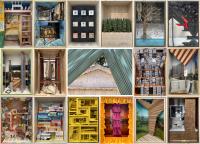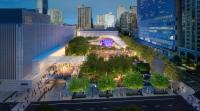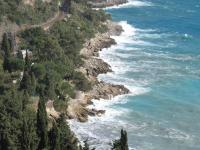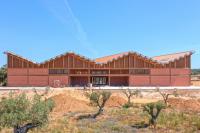CABEL Industry
Empoli, Italy
Just out the edge of the town of Empoli, the building is the Cabel Industry headquarters (a company dealing in computer systems for banks), it covers an area of approximately 4.500 square metres over several levels and it is incorporated on the small local industrial estate setting up new dialectical relations with the local manufacturing fabric. Commitment asked us to project an office building to be constructed using industrial methods by keeping down costs and time of construction. We decided to design a new precast concrete panel featured to be stand on the two main facades. Partially set into the ground, the building is composed of two extended floors out the ground level and a vault under. Along the main front the facade is protected by a long strip of public landscaping running parallel to the road. The visitor arrives on the ground level through three suspended bridges launched on a large excavation which lights the vault designed to house expositions and art installations. At night time this empty space becomes a pool of light which allows the architecture to detach itself from the ground, making it look like a lightweightmulticolored object suspended in the dark. Inside the building the underground level holds a printing facility and other spaces allocated for various different kinds of activities; the ground floor features all different sorts of glazed spaces, ranging from open plan spaces to small isolated cells, in a modern interaction of liquid working areas like acquarium. In contrast the first floor accomodates the management space, with a small internal patio and terrace in-between them. The elevators and distributional stairs take up the middle section of the structural grid, made of stone tiles with steel elevators. The gently curving building shell, windows, entrance gaps and furniture decoration all feature the same basic stylistic design. During the day coloured glass create liquid chromatic effects inside black and white offices, instead of night time when coloured cuts project out vivid lighting effects underlining holes, cuts and shapes of the building. The building is constructed out of prefabricated concrete elements (painted with white protective enamel) and its roof and end sections are tiled in grey aluminium. Starting from outside, external wall consists of precast concrete pannel, 80 mm thermal insulation, Knauf plasterboard. Everywhere suspended floors are made of fine porcelain (gres). Inside ceilings consist of plasterboard (modular or continuous) with thermal insulation under. So the thermal factor among the floors is optimized for reducing energetic consumption in climatic control. The entire roof is covered with a system of photovoltaic solar panels using amorphous polycrystalline tecnology, carefully positioned so as not be visible. Thanks to this system, which is capable of generating approximately 150 kW, the building is almost totally self-sufficient from an energy viewpoint.














